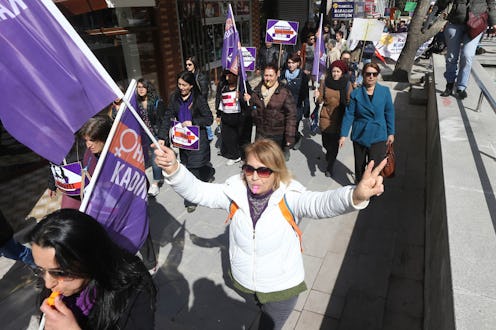News
What IWD 2016's #PledgeForParity Means
International Women's Day takes place on Tuesday, March 8, and the 2016 campaign theme is #PledgeForParity. The campaign is designed to motivate individuals and organizations to take concrete action to propel gender equality in a variety of areas and around the world. But what does the "Pledge for Parity" mean, and what can you do to participate?
The International Women's Day campaign is taking its cue from the 2015 World Economic Forum report on the state of gender parity worldwide; the report predicted that the global gender gap will not be closed until 2133 at its current rate of progress. That represents a slowing of progress from the previous year's report, which set the predicted year at 2095. The World Economic Forum explained that its Global Gender Gap Index of 2015 "ranks 145 economies according to how well they are leveraging their female talent pool, based on economic, educational, health-based and political indicators."
Highlights from the report show that, while men's average global earnings have almost doubled since 2006, women are only now earning what men were earning that year — 10 whole years ago. It also notes that, despite increased participation in higher education in many countries, women account for the majority of leaders in only four of the countries, and a majority of skilled workers in 68. Only 19 percent of parliamentarians from the countries are women, which speaks to massive continued political inequality.
The #PledgeForParity campaign wants to accelerate the closing of these gender gaps, and encourages men, women, and organizations to start now. You can pledge to contribute to that effort in one of five areas (though, of course, nobody will be mad at you for doing more than one!), summarized below:
- "Help women and girls achieve their ambitions": Organizations can pledge to provide women with career opportunities that match their skill level and provide experiences needed for advancement; women can pledge to advocate for themselves and serve as role models.
- "Challenge conscious and unconscious bias": Organizations can commit to fostering cultures of inclusion; individuals can commit to identifying and addressing personal biases.
- "Call for gender-balanced leadership": Organizations can pledge to expose women to experiences needed to obtain senior-level positions; women can pledge to avail themselves of mentoring, leadership, and advancement programs.
- "Value women and men's contributions equally": Organizations can commit to practicing fair and equitable talent recognition; individuals can learn from different perspectives and work with diverse groups.
- "Create inclusive, flexible cultures": Organizations can pledge to promote more flexible working environments so that age, gender, geography, and rank don't interfere with career advancement; individuals can advocate for more choice concerning how work gets done, when, and where.
Simply select one of the options, the country in which you live, and your gender (includes "non-binary/third gender" option), and submit your pledge. Fulfilling your pledge won't be quite as simple, but effort is necessary for bringing about gender parity.
